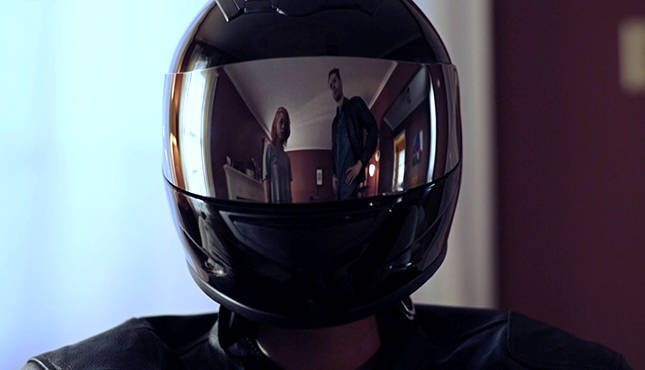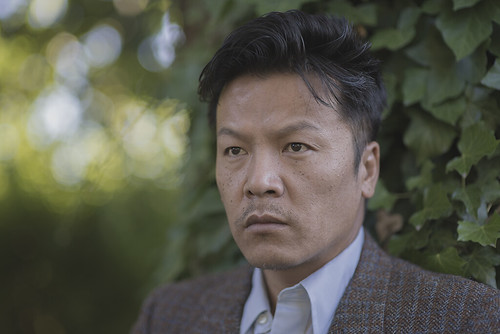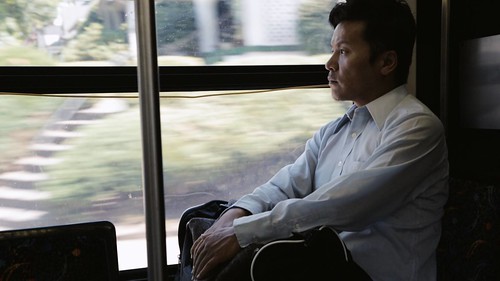Movies & TV / Columns
Lobsang Tenzin Speaks w/411 About His Latest Film The Lower Rooms

The 411 Interview: Lobsang Tenzin
Lobsang Tenzin is an award winning actor and filmmaker who makes his big screen debut in The Lower Rooms, directed by Barry Hunt and Nathan Wilson (check out my review of the movie here). Tenzin plays Tenzin, a Tibetan refugee in America seeking rehabilitation. Tenzin’s performance in the film won the Best Actor award at the 2016 Oregon Independent Film Festival. Tenzin is also the recipient of the Robert Redford Milagro Scholarship and the Santa Fe University of Art and Design and the owner of Blue Yak Films. In this interview Tenzin talks with this writer about his experience working on The Lower Rooms and more.
**
Bryan Kristopowitz: How did you get involved in The Lower Rooms?
Lobsang Tenzin: When I was in Mt. Hood Community College I was taking radiology prerequisites. After that I moved to Integrated Media in Mt. Hood Community College and one of my professors, her name is Dmae Roberts, one day asked me, “Hey Tenzin, are you interested in acting or anything?” She then introduced me to Barry Hunt. I had never met Barry Hunt before, and Barry Hunt is looking for an Asian looking actor, similar to me, I guess. So, once I met Barry Hunt, at Crema Coffee I think, he asked me if I was willing to do this, he told me he was shooting a movie, so, I’m a little bit excited. I was also a little bit, like, nervous, because if he does theater, you know, how you have to memorize all of the 150 pages of dialogue. And that’s how I met Barry and was introduced to The Lower Rooms.
BK: What was the most difficult aspect of making The Lower Rooms for you, as an actor? The easiest?
LT: I think the most difficult part working on this film was, since all of the dialogue and everything is in English, I have to, before I speak, you know, in my head, how do I actually put this word into a facial expression or eye movement. So, that was really difficult because if I am acting in Tibetan it just comes naturally. Before I speak my action, my facial gesture would show you what I am going to say. But this is now kind of the opposite. I have to think my dialogue and then deliver, and at the same time I have to deliver the action and emotion and everything. That was the most difficult part for me to work in the film. The easiest part was the crew and the director and the other actors. It felt like we became one family and there’s no nervousness, there’s no…it’s just like working as a team. So, it was a great experience and I think those are the easiest and the hardest parts for me working on this film.
BK: What was it like working with directors Barry Hunt and Nathan Wilson?
LT: Two totally different persons. The one thing in common between Barry Hunt and Nathan Wilson is they’re very calm, very calm. Very, very positive energy, you know. There is no, what do you call it in English, like they have to finish it right away, but just very, very calm. The thing is, being a filmmaker myself, and working in the camera department, and when I was studying in Integrated Media, and working in TV, it is kind of uneasy, like always thinking how the camera movement is, and “Oh, I wish I had done this, this, and this.” But being an actor I learned to stay on your own position and not to indulge with other people. Barry was amazing on how to think, how to face the camera. Barry gave me a Meisner class. Along with Nathan, who was introduced to us that he was going to be the director, Tyler was there. Nathan has the skill of putting Barry’s imagination onto the screen. A great combination. You know, it’s more like a, I would say it’s more like when you want to make something like a cake, there’s a perfect, you know, yeast, egg and everything, but you don’t see how it’s going to come out, you know? But putting all your love and affection in that small subject and once it starts baking inside it becomes a nice cake and once you put it in your mouth and you actually appreciate that it is good. And that’s how I feel, you know, both of them have amazing chemistry working with each other.
BK: What was it like working with J’ena Sancartier, who plays Rosie?
LT: How do I put it? Working with J’ena is also a blessing. She is such an amazing actress and she has a really powerful presence on the screen. Sometimes I felt like, “I don’t know how to act this part,” it’s just really tricky and I can’t actually put my emotion 100% in there.” And then working with J’ena, she showed up, and you totally understand your emotion, your everything. Your face changes, because looking at her and she is talking to you, you also feel what she is going through. So, that was really amazing. I think J’ena will become a really good actor. I see a lot in her ability, her work process. I look forward to working with J’ena again.
BK: In The Lower Rooms your character Tenzin spends quite a bit of time at the public library. Is that something you yourself enjoy doing or was that a character trait that was in the script?
LT: At first, the character was named Paulo. Barry asked me to base the film on my personal life and he asked me “What are the things that need to change in this film?” So, I told him a little bit here and there. Like, it says for Paulo that he goes fishing and I’m thinking “Tibetan’s would never fish.” So we changed that fishing into something that we wanted to do. Barry has a better idea of what we changed, because there were a few things we needed to change, due to me doing the Tenzin character as Tibetan. The things that we don’t do as a tradition, in our own customs, we changed. So, I think Barry might have changed that to going to a library instead of going fishing, you know? He did change a few things so, I think Barry may give you a better answer. I am not a person that goes to the library all the time, unless I have to do some research.
BK: When did you know you wanted to act?
LT: When I was young I always wanted to. I always loved watching film, I always wanted to act and to work in film. That was kind of like my passion when I was young, but my parents and the community and everything, there’s no…you don’t see any Tibetan people working in the film industry, you don’t see anyone that is Tibetan acting in film who you can look upon and want to follow their road. It’s impossible. And then I joined the school dance troupe and Tibetan folk dances, folk plays, Tibetan traditional music and dances. I think that is the closest way I can be and that’s how I actually picked it up. That’s what I wanted to do when I was young.
And I remember when I was 14 or 15 one of my teachers asked me “What do you want to become when you get old?” and I said “I want to be a filmmaker.” He told me, like, “In your dreams.” Basically, he said to me, show me one Tibetan who is working in film and has produced film, and directing, this and that. “Show me one.” Nobody wants to do that because nobody makes any money because it is useless. That actually hit me really strong in my heart and I wanted to prove him wrong. Two months ago I went back to India and I actually met the teacher, the guy who told me I am not going to be an actor or work in film. I actually met him and we had tea and I talked with him about the previous school days when he told me and he doesn’t remember me. He doesn’t remember what he said, but I told him I do remember what he said. And then I told him I am doing this and this and this, so he was really, really happy. He said, “Now the term has been changed, I will never say don’t do filmmaking or try to be an actor. Now I am going to tell the kids, encourage them to do acting and joining in the film industry. Because now there is an example I can actually say, ‘Look at him, he’s doing it.”
You know, that’s what I wanted, to change the mentality of the youngsters right now. So, right now it’s like how are Tibetans getting to the big screen, getting into films, you know? The last time I went to India we did a 10 day class for Tibetan kids on how to make film. We’ve been working on different projects in India. We just recently opened an artist’s residency program, and also Studio 59. There are so many things happening.
BK: What are your goals as an actor and filmmaker?
LT: As I have mentioned, my goal is just to inspire the young kids, you know, and I also want to make a lot of art films so the kids can be inspired. But, my goal, my really tiny goal, is basically just to inspire the young Tibetan filmmakers, the young Tibetan actors. Show them a way, you know, that they can use me as a resource. Ask me any question, you know, guide them, show them the right way to do it, you know? I think that’s my main goal.
BK: Any acting or filmmaking heroes?
LT: No heroes, actually. How do I put it? I think I consider, I don’t know, because I don’t have any heroes, I only have a few life changing people that I have met and worked with. I’ve worked with amazing DP’s and gaffers and directors. I recently worked on a Coen brothers show, working camera under Bruno Delbonnel. He is a DP. He also shot Inside Llewyn Davis and also Emily, and also Harry Potter, and he was just recently nominated for The Darkest Hour, the Winston Churchill movie. So, I worked with Bruno Delbonnel and I will be working in April with Roger Deakins (Blade Runner, No Country for Old Men) in the camera department. We will be shooting in New Mexico, Albuquerque. I think these two are my people I have worked with and are kind of my mentors, my gurus, you know? I have only one real hero, my only real hero is the Dalai Lama. So these men are my gurus, I have learned so many things. And it’s not about just working on the film. It is about connecting with the people, understanding, listening to their stories, you know, and sharing each other’s culture. That’s the life, the human life, you know?
BK: Any upcoming projects you can tell us about?
LT: Yes, we have a couple projects that are lined up that I’ve been researching for almost 4 years. My friend, artist Tenzin Rigdol, he is a Tibetan contemporary artist, and he has been researching almost 7 years now, researching on Tibetan road builders from 1959 to 1970.
Tibet has a lot of history from the 5th Century until the 20th Century, we have all these different amazing histories. But when we lost our country between 1959, 1960 to 1970, in between those 10 years, Tibetans were escaping from Tibet. So during that 10 years there’s no story, there’s no written archive, there’s no pictures about how Tibetans have fled, how people have survived and struggled and were put into road building projects in India, and Tibetans who were caught while escaping, they were also put into road building inside Tibet. We researched almost 150 people. All the people that we researched during that time are in really critical condition because they are all 88, 89, 90 years old so you have to move really fast because of their health issues. So all the people we have researched are very old people and each person we have interviewed almost 6, 7 hours, 8 hours, sometimes 9 hours. That’s a very exciting project and also a very important project for me and for the Tibetans, you know? This is also archiving history. Tenzin Rigdol right now is transcribing all the audio and he’s going to publish a book and we are going to make a documentary film on the road building project and there will be a couple of comic books on the road building project. I am directing the road builder project and my other friend, Mr. Shantanu Sagara (he’s my old college friend, we both graduated at the same time), he is also working as my co-director. He is in Mumbai and we both are working on this right now.
Also, we opened an artist’s dialogue, an artist residency project, a Dialogue Artist Residency in Dharamsala in India. We also opened Studio 59. You can rent equipment. It’s a really small, tiny studio up in the village, up in the mountain where you can not only rent equipment but teach how to tell stories through the camera, not only for the Tibetans but for the indigenous people who live with us in that area. They’re also losing their tradition, they’re also losing their dialect. It’s not necessarily that we want to preserve our own culture, we also wanted to help other indigenous people to tell their own stories, to preserve their own culture, too. These are the projects that we have so far. There are so many projects I wanted to tell you but, you know, once I put all the projects down I almost, 5 projects you push down together, it’s like 10 years each project. Some of them are 15 year projects, and that comes almost to my turning 80 years old, 90 years old, you know? So, we are working hard.
BK: What is Blue Yak Films?
LT: It is a website. When I first graduated from Integrated Media, Mt Hood Community College, being a graduate you have to make your business cards, your website. So I made this website Blue Yak Films. Blue Yak Films was built by one of my good friends, Christian Broadbent. It’s unfortunate. He recently passed away. He took care of the website. I think the website is down. I cannot upgrade or anything, you know, because it’s under his control. So, Blue Yak Films you can also watch on Vimeo. It’s exactly the same thing.
**
A very special thanks to Lobsang Tenzin for agreeing to participate in this interview, Barry Hunt for transcribing it, and david j. moore for helping set it up.
You can check out The Lower Rooms here.
You can check out the The Lower Rooms Facebook page here.
You can check out Lobsang Tenzin’s Facebook page here and his Instagram page here.
You can check out the Sowelu official website here.
All images courtesy of Barry Hunt and The Lower Rooms Facebook page.










